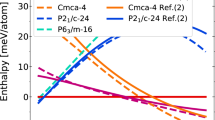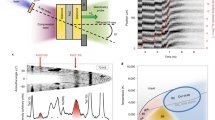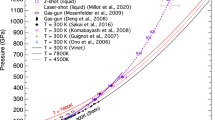Abstract
Following the discovery of stishovite (the highest-pressure polymorph of silica known from natural samples), many attempts have been made to investigate the possible existence of denser phases of silica at higher pressures. Based on the crystal structures observed in chemical analogues of silica1,2,3, high-pressure experiments on silica4,5,6,7,8,9,10,11 and theoretical studies12,13,14,15,16, several possible post-stishovite phases have been suggested. But the likely stable phase of silica at pressures and temperatures representative of Earth's lower mantle remains uncertain. Here we report the results of an X-ray diffraction study of silica that has been heated to temperatures above ∼2,000 K and maintained at pressures between 68 and 85 GPa. We observe the occurrence of a new high-pressure phase which we identify with the aid of first-principles total-energy calculations. The structure of this phase (space group Pnc2) is intermediate between the α-PbO2 and ZrO2 structures, and is denser than other known silica phases.
This is a preview of subscription content, access via your institution
Access options
Subscribe to this journal
Receive 51 print issues and online access
$199.00 per year
only $3.90 per issue
Buy this article
- Purchase on Springer Link
- Instant access to full article PDF
Prices may be subject to local taxes which are calculated during checkout



Similar content being viewed by others
References
Sato, H. et al. Baddeleyite-type high-pressure phase of TiO2. Science 251, 786–788 (1991).
Ming, L. S. & Manghnani, M. N. in High Pressure Research in Geophysics(eds Manghnani, M. H. & Akimoto, S.) 348–357 (Centre of Academic Publications, Tokyo, (1982)).
Tang, J. & Endo, S. in High-Pressure Science and Technology Pt 1(eds Schmidt, Sc., Shaner, J. W., Samara, G. A. & Ross, M.) 367–370 (Am. Inst. Phys. Woodbury, New York, (1994).
Altshuler, L. V. & Produrec, M. A. High-density fluorite and rutile polymorphs. Solid State Phys. 15, 1436–1441 (1973) (in Russian).
Simakov, T. New data on compressibility of oxides and fluorites and the theory of homogeneous Earth's composition. Trans. USSR Acad. Sci. 310, 1447–1449 (1991) (in Russian).
Sekine, T., Akaishi, M. & Setaka, N. Fe2N-type SiO2from shocked quartz. Geochim. Cosmochim. Acta 51, 379–381 (1987).
Liu, L. High Pressure Research in Geophysics(eds Manghnani, M. H. & Akimoto, S.) 329–347 (Center of Academic Publications, Tokyo, (1982)).
Tsuchida, Y. & Yagi, T. Anew, post-stishovite high-pressure polymorph of silica. Nature 340, 217–220 (1989).
Hemley, R. J. in High-Pressure Research in Mineral Physics(eds Syono, Y. & Manghnani, M. H.) 347–359 (Terra Scientific, Tokyo & Am. Geophys. Un., Washington DC, (1987).
Kingma, K. J., Cohen, R. E., Hemley, R. J. & Mao, H. K. Transformation of stishovite to a denser phase at lower-mantle pressures. Nature 374, 243–245 (1995).
Kingma, K. J., Mao, H. K. & Hemley, R. J. Synchrotron x-ray diffraction of SiO2 to multimegabar pressures. High Press. Res. 14, 363–374 (1996).
Tse, J. S., Klug, D. D. & Page, Y. L. Novel high-pressure phase of silica. Phys. Rev. Lett. 69, 3647–3649 (1992).
Lacks, D. J. & Gordon, R. G. Calculations of pressure-induced phase transitions in silica. J. Geophys. Res. 98, 22147–22155 (1993).
Dubrovinsky, L. S., Belonoshko, A. B., Dubrovinsky, N. A. & Saxena, S. K. New High-pressure Silica Phases Obtained by Computer Simulation 921–923 (AIRAPT/EHPRG Rep., World Scientific, Warsaw, Poland, (1996)).
Belonoshko, A. B., Dubrovnsky, L. S. & Dubrovinsky, N. A. Anew high-pressure silica phase obtained by molecular dynamics. Am. Mineral. 81, 785–788 (1996).
Karki, B. B., Warren, M. C., Stixrude, L., Ackland, G. J. & Crain, J. Ab initio studies of high-pressure structural transformations in silica. Phys. Rev. B 55, 3465–3471 (1997).
Saxena, S. K., Shen, G. & Lazor, P. Experimental evidence for new iron phase and implications for Earth's core. Science 260, 1312–1314 (1993).
Saxena, S. K., Chatterjee, N., Fei, Y. & Shen, G. Thermodynamic Data on Oxides and Silicates(Springer, Berlin, (1993)).
Ross, N. L., Shu, J. F., Hazen, R. M. & Gasparik, T. High-pressure crystal chemistry of stishovite. Am. Mineral. 75, 739–747 (1990).
Cohen, R. E. in High Pressure Research: Application to Earth and Planetary Sciences(eds Syono, Y. & Manghnani, M. H.) 425–431 (Geophys. Monogr. 67, Am. Geophys. Un., Washington DC, (1992)).
Willis, J. M. & Cooper, R. B. Synthesis of band and model Hamiltonian theory for hybridizing cerium systems. Phys. Rev. B 36, 3809–3823 (1987).
Hedin, L. & Lundqvist, B. I. Explicit local exchange-correlation potentials. J. Phys. C 4, 2064–2083 (1971).
Andersen, O. K. Linear methods in band theory. Phys. Rev. B 12, 3060–3083 (1975).
Skriver, H. L. The LMTO Method(Springer, Berlin, (1984)).
Acknowledgements
We thank J. Hu and G. Shen for their help in conducting the X-ray experiments, and N. Dubrovinsky for discussions. This work has been supported by the Swedish Natural Science Research Council (NFR), the Royal Swedish Academy of Sciences, and the Swedish Materials Consortium No. 9 financed by NUTEK, NFR and the Wallenberg Foundation.
Author information
Authors and Affiliations
Corresponding author
Rights and permissions
About this article
Cite this article
Dubrovinsky, L., Saxena, S., Lazor, P. et al. Experimental and theoretical identification of a new high-pressure phase of silica. Nature 388, 362–365 (1997). https://doi.org/10.1038/41066
Received:
Accepted:
Issue Date:
DOI: https://doi.org/10.1038/41066
This article is cited by
-
High-pressure polymorphs of olivine and silica in Kamargaon (L6) chondrite by laser micro-Raman and XRD studies
Journal of Earth System Science (2022)
-
Compressional pathways of α-cristobalite, structure of cristobalite X-I, and towards the understanding of seifertite formation
Nature Communications (2017)
-
Polymorphic phase transition mechanism of compressed coesite
Nature Communications (2015)
-
Fracture-induced amorphization of polycrystalline SiO2 stishovite: a potential platform for toughening in ceramics
Scientific Reports (2014)
-
Quenching ilmenite with a high-temperature and high-pressure phase using super-high-energy ball milling
Scientific Reports (2014)
Comments
By submitting a comment you agree to abide by our Terms and Community Guidelines. If you find something abusive or that does not comply with our terms or guidelines please flag it as inappropriate.



